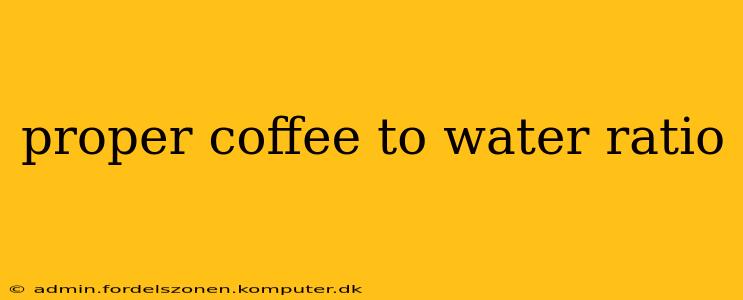Finding the perfect coffee-to-water ratio is crucial for unlocking the full potential of your beans. Whether you're a seasoned barista or a novice coffee enthusiast, understanding this fundamental aspect of brewing will elevate your coffee experience from mundane to magnificent. This guide explores the ideal ratios, delves into the impact of different brewing methods, and addresses common questions surrounding this vital element of coffee preparation.
What is the Standard Coffee-to-Water Ratio?
The generally accepted standard coffee-to-water ratio is a 1:15 ratio, meaning one gram of coffee grounds for every 15 grams of water. This translates roughly to two tablespoons of ground coffee for every six ounces of water. However, this is just a starting point; personal preferences and brewing methods significantly influence the ideal ratio. Experimentation is key to discovering your perfect cup.
How Does the Coffee-to-Water Ratio Affect My Coffee?
The coffee-to-water ratio directly impacts several aspects of your brewed coffee:
- Strength: A higher coffee-to-water ratio (e.g., 1:12) results in a stronger, more intense brew. A lower ratio (e.g., 1:18) produces a weaker, more delicate cup.
- Flavor: The ratio influences the extraction of different flavor compounds from the coffee grounds. A perfectly balanced ratio brings out the nuanced flavors of the beans, while an imbalanced ratio can lead to bitterness (too much coffee) or weakness (too little).
- Body: The ratio contributes to the mouthfeel of your coffee. A higher ratio generally creates a thicker, heavier body, while a lower ratio results in a lighter, more delicate body.
What are the Best Coffee-to-Water Ratios for Different Brewing Methods?
Different brewing methods require slightly adjusted ratios to achieve optimal results. Here's a breakdown:
- Pour Over (e.g., Hario V60, Chemex): A ratio of 1:15 to 1:17 is generally recommended for pour-over methods. The precise control offered by pour-over allows for nuanced extraction at these ratios.
- French Press: A slightly higher ratio of 1:12 to 1:15 is often preferred for French press brewing. The immersion method used in French press extracts more oils and requires a slightly higher coffee concentration.
- Drip Coffee Maker: Most drip coffee makers benefit from a ratio between 1:15 and 1:16. Adjustments may be needed depending on the specific machine and desired strength.
- Aeropress: The Aeropress is versatile, accommodating ratios from 1:15 to 1:18, depending on your preference for strength and flavor.
What is the Best Grind Size for My Chosen Ratio?
The grind size significantly impacts extraction. A finer grind is generally needed for methods with shorter brewing times (e.g., espresso), while coarser grinds work best for longer brew times (e.g., French press). Always adjust your grind size to match your chosen brewing method and coffee-to-water ratio for optimal results.
How Can I Experiment to Find My Perfect Ratio?
The best way to find your perfect ratio is through experimentation. Start with the standard 1:15 ratio and adjust incrementally, keeping detailed notes on your observations. Consider factors like:
- Bean Type: Different bean origins and roasts require slightly different ratios.
- Personal Preference: Your taste buds are the ultimate judge.
What if my coffee is too bitter?
A bitter brew often indicates an over-extracted coffee, typically caused by using too much coffee, too fine a grind, or brewing for too long. Try reducing the coffee-to-water ratio, using a coarser grind, or decreasing your brewing time.
What if my coffee is too weak?
Weak coffee often means under-extraction. This could be due to using too little coffee, too coarse a grind, or brewing for too short a time. Try increasing the coffee-to-water ratio, using a finer grind, or increasing your brewing time.
How do I measure coffee accurately?
Using a scale is the most accurate method for measuring both coffee and water. This ensures consistency and reproducibility in your brewing. Digital kitchen scales are readily available and provide precise measurements.
By understanding the coffee-to-water ratio and its impact on your brew, you can embark on a journey of coffee exploration, ultimately leading to the perfect cup tailored to your preferences. Happy brewing!
